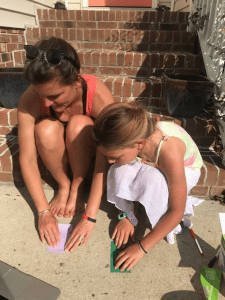SMART Goals for Health and Wellness
Encourage children to set SMART goals around nutrition and wellness in order to become healthier and happier versions of themselves.
Read More Looking to blow off some steam with the kids this summer? Make it STEAM instead and you’ll get the added bonus of teaching important lessons like critical thinking, collaboration, and creativity, all while promoting positive learning and resilience. And having fun, of course!
Looking to blow off some steam with the kids this summer? Make it STEAM instead and you’ll get the added bonus of teaching important lessons like critical thinking, collaboration, and creativity, all while promoting positive learning and resilience. And having fun, of course!
STEAM refers to activities that integrate science, technology, engineering, arts, and/or mathematics. Incorporating STEAM activities into everyday learning and play provides children with unique opportunities to create and experiment. We’ve put together a list of some of our favorite STEAM activities that you can do with kids from PK-8th grade, most of which require materials you likely already have around the house. We’ve also added fun talking points to give you ideas for how to discuss the STEAM subjects in more depth and tie themes back to movement, play and social-emotional well-being. Check the activities out below and make sure to grab the camera before you get started, you’ll want to capture these moments!
Activities for PK-2nd Grade:
If-Then Backyard Coding Game (Left Brain Craft Brain)
Materials you’ll need:
Talk with your kids about: the various places that coding and if-then statements can be found all around us and discuss the importance of responsible decision making.
Salt Painting (The Artful Painting)
Materials you’ll need:
Talk with your kids about: chemical reactions and use different colors to express different feelings and emotions.
Drawing on Eggs (iGame Mom)
Materials you’ll need:
Talk with your kids about: chemical reactions and use different colors or drawings of faces to express different feelings and emotions.
Activities for 3rd-5th Grade:
Expanding Ivory Soap (The STEM Laboratory)
Materials you’ll need:
Talk with your kids about: testing a hypothesis for what will happen to the soap. At the end of the activity, reflect on why it’s important to talk about how we are feeling so things don’t get bottled up and erupt (or expand like the soap).
Light Refraction Drawing (Go Science Kids)
Materials you’ll need:
Talk with your kids about: how water and light manipulate shapes. Explore empathy by talking about the importance of seeing different perspectives to better understand others and how they might be feeling.
Activities for 6th-8th Grade:
Geometric Math Art Circles (Teach Beside Me)
Materials you’ll need:
Talk with your kids about: how patterns are all about math and ways in which repetition (in activities like mindful breathing, counting, etc.) can help us regulate how we feel.
Build a Functioning Heart Model (STEAM Powered Family)
Materials you’ll need:
Talk with your kids about: the components that make up our bodies. Want to take it a step further? Get moving and calculate your heart rate during different activities.
Build your child’s interest in STEAM projects by relating them to a favorite hobby of your child’s, like sports, photography, LEGOs, music, etc.
Don’t worry about including every component of STEAM (science, technology, engineering, art, and math) into one project. These projects can be simple and many times focusing on just one or two is the way to go!
Get creative with the objects and materials you have easy access to – or go outside and grab some from nature.
Get older kids involved by having them teach and model the activities with younger kids.
For more activities and ideas like this one, be sure to sign up for our news and updates. And if you like what you see, please donate to support our work creating more ways to help build a healthier future for kids.
Categories: Social-Emotional Health, At Home, At School, Digital Resource